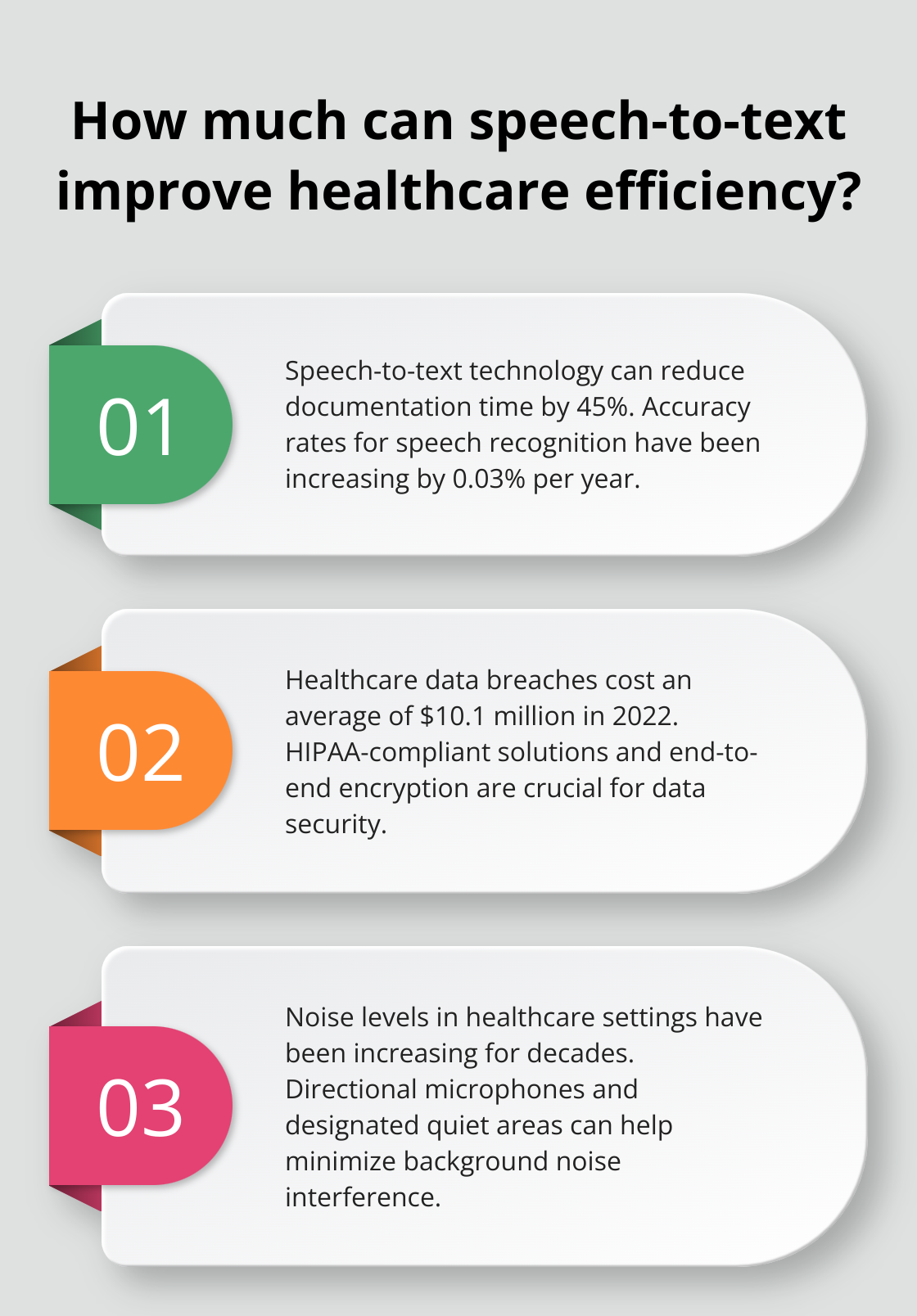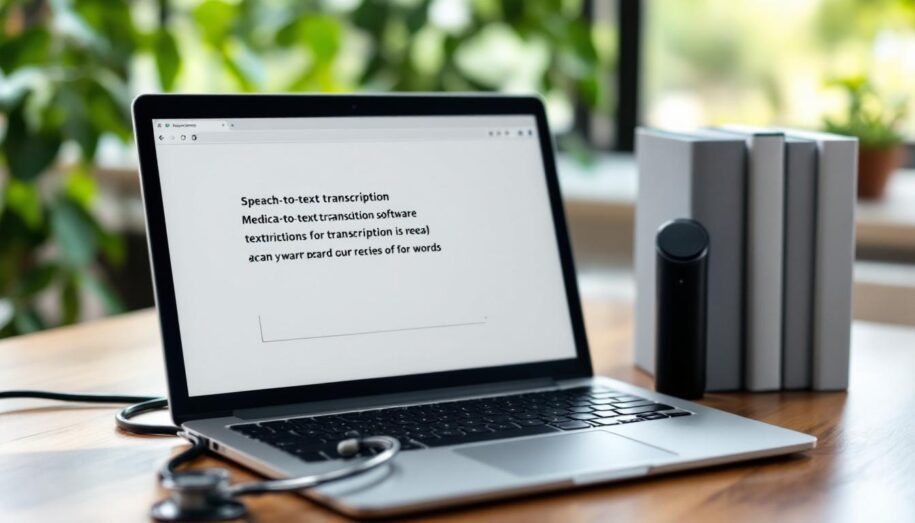Speech-to-text medical transcription—game changer for healthcare documentation. It flips spoken words into written text, making the whole patient info and medical note thing a breeze. Seriously, it’s like night and day.
At ScriberJoy, we’re front-row witnessing how these speech-to-text wonders can supercharge efficiency and precision in medical setups. So, let’s chat about steering this tech ship in your healthcare dock—from picking the right software (spoiler: it’s crucial) to dodging those pesky hurdles.
What Is Speech-to-Text in Medical Transcription?
The Basics of Speech-to-Text Technology
Alright, folks, let’s dive into speech-to-text technology-because it’s kind of a game-changer for medical transcription. Think of it as your healthcare documentation superhero, turning spoken words into written text at lightning speed. It listens to the docs yakking away and scribbles it all down in real-time, reducing paperwork to a whisper.
How It Works in Healthcare Settings
In the hustle and bustle of medical life, speech-to-text software employs some seriously advanced algorithms. It recognizes speech patterns, medical jargon, and accents. So when a doctor tosses out “myocardial infarction,” the software nods along, transcribing it with a knowing smirk-understanding the medical essence of it all.
Tangible Benefits for Healthcare Providers
Now, let’s talk benefits, because they are… substantial. A study evaluated the time and cost savings brought about by speech recognition tech, and I gotta say, it has the potential to revamp healthcare processes.

But hold your horses-there’s a plot twist. Speech-to-text tech can also impact how accurate documentation is. Turns out, a study found more errors creep in when docs go voice-first compared to old-school keyboarding-138 errors versus 32, to be precise.
AI: The Accuracy Enhancer
Enter Artificial Intelligence (AI), the magic behind standout accuracy in speech-to-text systems in medical settings. AI learns from gigantic datasets of medical lingo, allowing it to decode the most tangled medical terms with a surgeon’s precision.
For example, the Deepgram Nova-2 Medical Speech-to-Text model cranked up its word recall for medical terms by 16% compared to its previous version. Which… is clutch in healthcare, where even a tiny slip can snowball into big problems.
AI has another trick up its sleeve-it learns continuously. As it processes new speech quirks and vocab, it upgrades itself. So, the more a healthcare pro uses it, the sharper it gets at decoding their unique speech and their special brand of vocabulary.
Choosing the Right Solution
Fast forward to picking a solution-it’s a bit of a minefield. You want a speech-to-text wiz that can tackle the distinctive challenges of medical transcription. Take ScriberJoy, for instance-it fuses AI with human oversight, promising over 99% accuracy in medical notes. This dual punch offers the speed of AI with the deep understanding only a human can bring, leading to unmatched accuracy and speed.
Looking ahead, the challenge is to nail down how to saddle up this tech effectively in the medical world. We’ll uncover the best practices to weave this tech marvel into your healthcare routine like a well-tailored suit.
How to Implement Speech-to-Text in Medical Settings
Selecting the Right Software
First things first-accuracy reigns supreme when it comes to picking speech-to-text software for medical settings. You want to go for those solutions crafted just for healthcare, brimming with a rich medical vocabulary. Take Deepgram Nova-2 Medical for example-this beast boosts word error rate (WER) by 11% for pre-recorded transcription, outclassing its previous version by a whopping 42.8%.

Now, about integration: it’s key. Your software should fit like a glove with your current systems, streamlining workflow without hiccups. And don’t forget to lean toward options that keep medical dictionaries fresh and offer tweaks for those specialty terms.
Then there’s the money angle. High sticker price? Maybe. But think long game… big savings in time and cash later on.
Training Your Medical Staff
Let’s talk foundation-the bedrock of implementing speech-to-text is solid staff training. Kick off with an all-in-one onboarding program spanning tech stuff and the ABC’s of clear dictation.
Here’s the drill: encourage speaking clearly and not too fast, with an extra nudge to enunciate those tricky medical terms. Turn up the dial on accuracy by ensuring a peaceful environment.
What else works? Buddying up seasoned staff with newbies… peer learning speeds up adoption and smooths over common bumps. Regular refreshers and the 411 on new features? Yep, keep those skills top-notch.
Integrating with Existing Systems
Skipping a beat won’t do-you want seamless integration with your Electronic Health Record (EHR) system to get the most out of speech-to-text. Hunt for solutions with APIs or direct links to top-tier EHR platforms. The payoff? Bye-bye manual data entry, and transcription errors take a nosedive.
Phased rollout is your friend. Test waters with a pilot in one department-a small batch of providers-before splashing out across the board.
IT folks should be in on it from Day 1. They’ll handle tech challenges and ensure compliance and security-HIPAA’s not something you wing.
Overcoming Initial Challenges
Here’s a spoiler: there’s a learning curve. Face those pesky challenges-like battling background noise or accents-head-on. Extra support for those struggling can be the game-changer.
Got feedback? Use it. Staff input can fine-tune the process and boost that sense of ownership.
As your crew gets the hang of voice recognition software, you’ll see a major cut in doc time. This surge in efficiency? More time for patient care, leveling up the healthcare game. Next up-tackling obstacles that might pop up along the way.
Tackling Speech-to-Text Hurdles in Healthcare
Navigating Accents and Speech Variations
Accents and speech variations-oh boy, a real headache for even the flashiest speech recognition tech. Studies show that overall, accuracy rates haven’t exactly been sky-rocketing … with a sluggish uptick of 0.03% per year. Yikes.

So, what’s the plan here?
- Customize language models: Think of it like a personal trainer for your speech system. Adjust it to tackle the specific accents or dialects that are front and center in your healthcare arena.
- Implement user profiles: Personalized playlists of speech patterns. The system learns, adapts, maybe even thrives on your unique voice quirks over time.
- Conduct accent-specific training: Get everyone on the same page. Pronunciation boot camps focusing on those tricky medical lingo bits. A game changer for recognition.
Minimizing Background Noise Interference
Healthcare settings … let’s face it, not the quietest zones on planet Earth. Studies indicate that noise levels have been cranking up for decades, shooting past WHO’s “community noise” suggestions.
Here’s how to tone it down:
- Use directional microphones: If you can’t silence the world-focus it. These mics zoom in on the speaker while sidelining the clatter.
- Choose software with noise reduction: Many brainy speech-to-text tools come with noise reduction powers. Make sure yours knows the vibe.
- Designate quiet dictation areas: A whispering zone away from the hustle-bustle? Yes, please. Set up these dictation oases if you can.
Safeguarding Patient Privacy and Data Security
Tech in healthcare is skyrocketing and so is the need to keep patient info on lockdown. IBM’s 2022 check-in revealed a staggering $10.1 million average for healthcare data breaches. Insane, right?
Here’s how to play it safe:
- Choose HIPAA-compliant solutions: Your speech-to-text option should hit those HIPAA health checkboxes. (Consider ScriberJoy-a solid HIPAA buddy.)
- Implement end-to-end encryption: Guard your data in transit and at rest … just like a digital fortress.
- Use multi-factor authentication: More gates mean less risk; keep those unauthorized peepers out.
- Conduct regular security audits: Keep your defense up-to-date and ready to face potential threats head-on.
- Train staff on data protection: Knowledge is power. Arm your team with privacy know-how to sidestep breaches.
Addressing Technical Limitations
Speech-to-text-despite its shiny exterior-still gets tripped up now and then. Stuffy medical terms, tricky context, and the occasional system hiccup aren’t doing anyone favors.
Here’s the tech fix:
- Regularly update software: Keep that speech-to-text tech fresh and bug-free with the latest updates.
- Provide ongoing training: Make sure your team knows the ropes … and the ropes’ ropes.
- Maintain a feedback loop: Don’t let problems fester. Encourage reporting to keep the system on its A-game.
Overcoming Resistance to Change
Introducing new tech? Buckle up for the pushback from fans of the old ways-but it doesn’t have to be a slow-motion drama fest.
Steps to win hearts and minds:
- Communicate benefits clearly: Spell out how this tech is a time-saver, with accuracy boosts-documentation time, sliced by 45%? Yes, really.
- Provide comprehensive support: Be the help desk hero-instant support to smooth out any tech wrinkles users face.
- Celebrate early wins: Turn those initial success stories into a rallying cry. Momentum is vital-fuel it well.
By tackling these issues, healthcare pros can boost both accuracy and efficiency in medical transcription, pushing the needle on patient care and operational excellence.
Final Thoughts
Speech-to-text medical transcription… let’s talk about a game changer. It’s flipping the entire healthcare script, slashing paperwork time, and letting those healthcare heroes-yep, the providers-actually focus on what we’re all here for: the patients. This tech isn’t just about efficiency-it’s got accuracy nailed down and boosts patient satisfaction, too. Picture a future where AI and machine learning aren’t just buzzwords but are crafting more sophisticated systems. That’s where we’re headed.

So, healthcare providers-it’s time. Dive into speech-to-text solutions now. Streamline your workflow, make patient outcomes your best friend. Sure, implementation has its hurdles… but the benefits? They blow the challenges out of the water. Enter ScriberJoy with their AI-powered medical transcription software. It’s cutting-edge tech served with a side of human touch for spot-on documentation.
Healthcare documentation… experts say it needs to speak your language. Speech-to-text transcription sets you ahead of the pack, driving care that’s efficient, accurate, and-most importantly-patient-focused. Ready to level up your healthcare documentation game? Start today.

Leave a Reply
You must be logged in to post a comment.